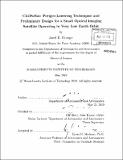| dc.contributor.advisor | John Keesee. | en_US |
| dc.contributor.author | Krueger, Jared K. (Jared Keith) | en_US |
| dc.contributor.other | Massachusetts Institute of Technology. Dept. of Aeronautics and Astronautics. | en_US |
| dc.date.accessioned | 2011-06-20T15:52:00Z | |
| dc.date.available | 2011-06-20T15:52:00Z | |
| dc.date.copyright | 2010 | en_US |
| dc.date.issued | 2010 | en_US |
| dc.identifier.uri | http://hdl.handle.net/1721.1/64565 | |
| dc.description | Thesis (S.M.)--Massachusetts Institute of Technology, Dept. of Aeronautics and Astronautics, 2010. | en_US |
| dc.description | Cataloged from PDF version of thesis. | en_US |
| dc.description | Includes bibliographical references (p. 125-126). | en_US |
| dc.description.abstract | The ever-increasing role of intelligence, surveillance, and reconnaissance (ISR) assets in combat may require relatively large numbers of earth observation spacecraft to maintain situational awareness. One way to reduce the cost of such systems is to operate at very low altitudes, thereby minimizing optics size and cost for a given ground resolution. This outside-the-box idea attempts to bridge the gap between high-altitude aerial reconnaissance platforms and traditional LEO satellites. Possible benefits from such a design include enabling a series of cheap, small satellites with improved optical resolution, greater resistance to adversary tracking, and 'quick strike' capability. In this thesis satellite systems design processes and tools are utilized to analyze advanced concepts of low perigee systems and reduce the useful perigee boundary of satellite orbits. The feasibility and utility of such designs are evaluated through the use of the Satellite System Design Tool (SSDT), an integrated approach using models and simulations in MATLAB and Satellite Tool Kit (STK). Finally a potential system design is suggested for a conceptual Continuous Low Orbit Surveillance Satellite (CLOSeSat). The proposed CLOSeSat design utilizes an advanced propulsion system and swooping maneuvers to improve survivability and extend lifetime at operational perigees as low as 160 kilometers, with sustained circular orbits at 240 kilometers. The views expressed in this thesis are those of the author and do not reflect the official policy or position of the United States Air Force, Department of Defense, or the U.S. Government. | en_US |
| dc.description.statementofresponsibility | by Jared K. Krueger. | en_US |
| dc.format.extent | 126 p. | en_US |
| dc.language.iso | eng | en_US |
| dc.publisher | Massachusetts Institute of Technology | en_US |
| dc.rights | M.I.T. theses are protected by
copyright. They may be viewed from this source for any purpose, but
reproduction or distribution in any format is prohibited without written
permission. See provided URL for inquiries about permission. | en_US |
| dc.rights.uri | http://dspace.mit.edu/handle/1721.1/7582 | en_US |
| dc.subject | Aeronautics and Astronautics. | en_US |
| dc.title | CLOSeSat : Perigee-lowering techniques and preliminary design for a small optical imaging satellite operating in very low earth orbit | en_US |
| dc.title.alternative | Continuous Low Orbit Surveillance Satellite | en_US |
| dc.title.alternative | Perigee-lowering techniques and preliminary design for a small optical imaging satellite operating in very low earth orbit | en_US |
| dc.type | Thesis | en_US |
| dc.description.degree | S.M. | en_US |
| dc.contributor.department | Massachusetts Institute of Technology. Department of Aeronautics and Astronautics | |
| dc.identifier.oclc | 726747939 | en_US |
